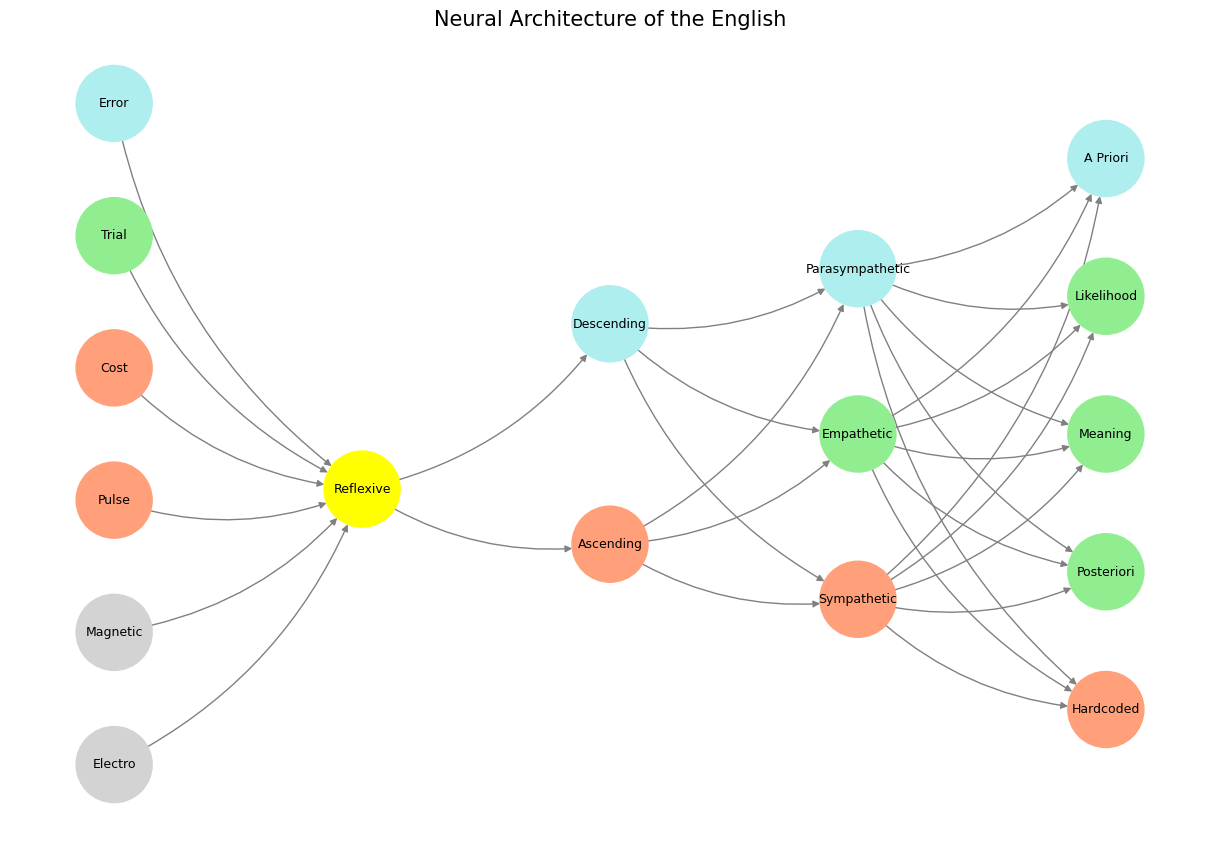Revolution#
Watching the English by Kate Fox is, at its core, an anthropology of autonomic responses—less about what the English say and more about how they regulate autonomic activation in social settings. The book, at its core, maps the nervous system of English society, encoding its conversational and behavioral rules into a lattice of homeostatic equilibria. The real game here is modulation—how to maintain an optimal balance between familiarity and unpredictability, ensuring that human interactions neither spiral into chaos nor congeal into robotic tedium. In this sense, English social behavior functions like a multi-layered neural network, each layer corresponding to a different level of complexity, from biological reflexes to the highest-order abstractions of cultural constraint.
Fig. 21 What Exactly is Identity. A node may represent goats (in general) and another sheep (in general). But the identity of any specific animal (not its species) is a network. For this reason we might have a “black sheep”, distinct in certain ways – perhaps more like a goat than other sheep. But that’s all dull stuff. Mistaken identity is often the fuel of comedy, usually when the adversarial is mistaken for the cooperative or even the transactional.#
At the first layer—the World, the Red Queen Hypothesis reigns supreme. This is life in the raw, a perpetual game of survival, where every interaction is an evolutionary wager. The English talk about the weather with the same predictability as an electromagnetic pulse ⚡ disrupting a field of static equilibrium. Weather talk is the roulette wheel 🎰 of conversation, the ultimate low-risk entry point where the odds of offense or controversy are effectively nil. Like a coin toss 🪙 or dice roll 🎲, it offers just enough randomness to lubricate social engagement while remaining within a comfortable 95/5 certainty ratio. These conversations, though trivial, are critical—they establish a rhythm, an acknowledgment of shared experience, and a first node in the web of social trust.
Moving into the second layer—Mode, the reflexive core of human engagement—conversation becomes slightly more complex, much like a game of poker ♣️♦️♥️. Grooming-talk and humor introduce an 80/20 dynamic, where wit and timing determine social status. Here, we begin to see the first traces of strategic interaction. The linguistic class codes of English speech play out like a card game—certain words and accents signal social rank, wealth, and education, with players adapting their conversational hands accordingly. Just as Victorian etiquette sought to regulate autonomic response, the English instinctively modulate their speech to manage tension, inserting humor as a release valve where necessary.
The third layer—Agent, the razor’s edge at 51/49, where top-down and bottom-up pathways intersect—resembles horse racing 🏇 and car racing 🏎️💨. This is where social interactions start accelerating, moving beyond conditioned reflexes into dynamic, iterative games of strategy. Work, rules of the road, and even everyday social navigation require real-time adaptation, balancing risk and reward with split-second decision-making. Here, the ascending and descending tracts of social cognition mirror the neurological pathways they represent: ascending tracts bringing raw sensory information into conscious awareness, and descending tracts refining behavior through learned experience. Just as a driver or jockey must adjust mid-course, so too must the Englishman, constantly negotiating micro-adjustments in conversation, dress, and play.
At the fourth layer—Space, the realm of deeper social entanglements—interactions shift into chess ♟️ and pub talk 🍺. This is where empathy, competition, and social maneuvering come into play. Drinking culture, in particular, operates within a 20/80 balance of social control versus chaos, where alcohol lubricates conversation but also loosens the tight constraints of English formality. Here, the sympathetic and parasympathetic nervous systems are locked in a dance, with social engagement modulating between relaxation and heightened stimulation. A pint in the pub can be either a friendly game of strategy or an adversarial match of wits, depending on context.
Finally, the fifth layer—Time, the most volatile, complex, and unpredictable domain—belongs to romantic relationships and sex 💘. At a staggering 5/95 uncertainty ratio, this is the ultimate social gamble, the domain where autonomic regulation is most fragile. Unlike the structured rhythms of weather talk or the iterative refinement of work and play, this space operates under a fundamentally different set of probabilities. Victorians, ever wary of this domain, sought to hardcode romantic engagement into elaborate courtship rituals, modulating autonomic response by imposing layers of inhibition and formality. But the reality remains: relationships are fraught with risk, laden with asymmetry, and driven by subconscious forces far beyond rational control.
Watching the English, then, is less about etiquette and more about calibration—how a society tunes its interactions to maintain balance within a chaotic biological ecosystem. The English social game, like any neural network, is about filtering noise, compressing combinatorial space, and searching for optimal pathways through an ever-shifting labyrinth of social cues. What emerges is a portrait of a people engaged in constant, delicate negotiation, navigating the odds of conversation, play, and romance with the same evolutionary instincts that govern survival in the wild.
Show code cell source
import numpy as np
import matplotlib.pyplot as plt
import networkx as nx
# Define the neural network fractal
def define_layers():
return {
'World': ['Electro', 'Magnetic', 'Pulse', 'Cost', 'Trial', 'Error', ], # Veni; 95/5
'Mode': ['Reflexive'], # Vidi; 80/20
'Agent': ['Ascending', 'Descending'], # Vici; Veni; 51/49
'Space': ['Sympathetic', 'Empathetic', 'Parasympathetic'], # Vidi; 20/80
'Time': ['Hardcoded', 'Posteriori', 'Meaning', 'Likelihood', 'A Priori'] # Vici; 5/95
}
# Assign colors to nodes
def assign_colors():
color_map = {
'yellow': ['Reflexive'],
'paleturquoise': ['Error', 'Descending', 'Parasympathetic', 'A Priori'],
'lightgreen': ['Trial', 'Empathetic', 'Likelihood', 'Meaning', 'Posteriori'],
'lightsalmon': [
'Pulse', 'Cost', 'Ascending',
'Sympathetic', 'Hardcoded'
],
}
return {node: color for color, nodes in color_map.items() for node in nodes}
# Calculate positions for nodes
def calculate_positions(layer, x_offset):
y_positions = np.linspace(-len(layer) / 2, len(layer) / 2, len(layer))
return [(x_offset, y) for y in y_positions]
# Create and visualize the neural network graph
def visualize_nn():
layers = define_layers()
colors = assign_colors()
G = nx.DiGraph()
pos = {}
node_colors = []
# Add nodes and assign positions
for i, (layer_name, nodes) in enumerate(layers.items()):
positions = calculate_positions(nodes, x_offset=i * 2)
for node, position in zip(nodes, positions):
G.add_node(node, layer=layer_name)
pos[node] = position
node_colors.append(colors.get(node, 'lightgray'))
# Add edges (automated for consecutive layers)
layer_names = list(layers.keys())
for i in range(len(layer_names) - 1):
source_layer, target_layer = layer_names[i], layer_names[i + 1]
for source in layers[source_layer]:
for target in layers[target_layer]:
G.add_edge(source, target)
# Draw the graph
plt.figure(figsize=(12, 8))
nx.draw(
G, pos, with_labels=True, node_color=node_colors, edge_color='gray',
node_size=3000, font_size=9, connectionstyle="arc3,rad=0.2"
)
plt.title("Neural Architecture of the English", fontsize=15)
plt.show()
# Run the visualization
visualize_nn()


Fig. 22 Psilocybin is itself biologically inactive but is quickly converted by the body to psilocin, which has mind-altering effects similar, in some aspects, to those of other classical psychedelics. Effects include euphoria, hallucinations, changes in perception, a distorted sense of time, and perceived spiritual experiences. It can also cause adverse reactions such as nausea and panic attacks. In Nahuatl, the language of the Aztecs, the mushrooms were called teonanácatl—literally “divine mushroom.” Source: Wikipedia#

